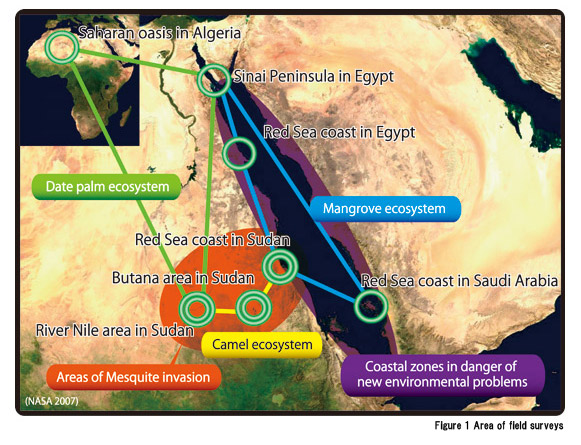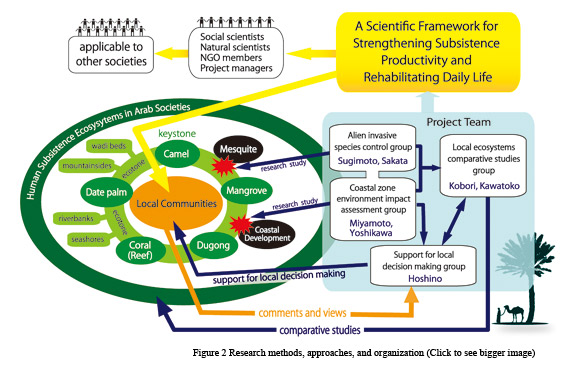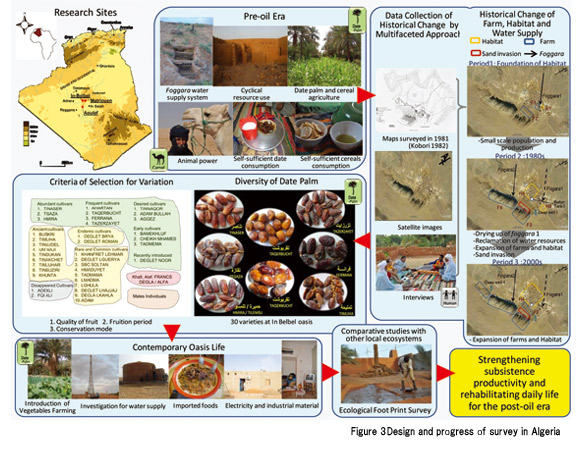- Background
For political, social, economic and environmental reasons, the Middle East now faces a turning point in modern oil-based development. Fossil fuel-based interdependencies must now be transformed into new relations that can support viable future societies.
This research project focuses on human subsistence ecosystems of the region: low energy-intensity life-support mechanisms and modes of production, such as hunting, gathering, fishing, herding, farming, and forestry. In doing so it also reflects on the role of advanced technologies in economic development, and assesses measures adopted thus far to combat desertification. Field research investigates keystone species, ecotones, and traditional knowledge. In sum it examines the sustainability of subsistence economies under site-specific conditions.
- Research methods and organization
The study is developed along three principal axes (Fig. 1): 1) botanical and ecological study of the alien invasive species mesquite, with emphasis on comprehensive measures for its control; 2) environmental impact assessment of development programs in coastal zones of the arid tropics; and 3) sharing of research results to support local decision making. Field research examines subsistence ecosystems, focusing on keystone species such as camels, date palm, dugong, mangrove, and coral reefs, and ecotones such as wadi beds, riverbanks, mountainsides, and seashores.
The members of this project include social and natural scientists, members of local NGOs, and project managers, who are divided into four study groups, concerned with the following (Fig. 2):

- 1. Alien invasive species control
A team of Japanese and Sudanese hydrologists, plant physiologists, weed scientists, remote-sensing specialists, range managers, agricultural economists, nutrient physiologists, and cultural anthropologists conducted field surveys at riverbanks, wadi beds, seashores and mountainsides in arid to semi-arid areas of Sudan. The group has developed a detailed description of the human and ecological factors affecting mesquite growth in several distinct environmental contexts, and suggested several potential measures that may be used for its control.
- 2. Environmental assessment in coastal zones
Forest structure, morphology, and water use of the keystone mangrove species Avicennia marina in the southern Egyptian Red Sea coast were studied in collaboration with the Nature Conservation Sector of the Egyptian Environmental Affairs Agency. Ten microsatellite markers on DNA analysis were found on collected samples. Parent-child relationship of A. marina may be revealed in further study at the RIHN laboratory. Local environmental researchers and administrators have begun extension courses to promote mangrove re-forestation along the Red Sea coast in Egypt and Saudi Arabia. Anthropological study on maritime societies demonstrates a high level of traditional ecological knowledge, particularly in regard to coral reef environments.
- 3. Support for local decision making
Three sites have been selected for field surveys: In Belbel, Matriouen and Aoulef. Surveys are to describe the Sahara oasis subsistence ecosystems in light of recent historical change (Fig. 3). Fieldworkers are anthropologists, biologists, geographers and historians; practitioners, consultants and motivated farmers also participate. Researchers from the Centre National de Développement des Ressources Biologiques (CNDRB) are to inventory fauna and flora at the sites and draft conservation projects involving local inhabitants.
Research shows that in pre-oil era (more than 50 years ago), human subsistence was based on self-sufficient social-ecological systems. Life depended on oasis resources. Date palm agriculture and groundwater-based irrigation systems, called foggara, were indispensable. There were also extensive extra-local networks based on camel transport. This mode of life has changed dramatically since the 1970s. The use of deep-water pumps has allowed oasis agriculture to expand, but new water sources are often not dependable. The use of foggara has declined. Date palms have become a commodity for export, not local consumption. Cous-cous, an imported food, is now a staple. Since October 2010 we have analyzed the ecological footprint associated with this conversion at a deep-pump irrigated date palm farm in Aoulef.
- Future tasks
Full-scale field surveys are now underway in each research area. In the next year we will begin comparative data analysis and consideration of best ways to disseminate findings. In particular, we are investigating potential alternative uses of uprooted invasive mesquite trees; Sudanese researchers are examining the species potential as fodder and charcoal. Another key task is the design of a coastal mangrove management and afforestation regime based on traditional uses.
|
|
|
|